七年级英语下册第六单元学案
- 格式:docx
- 大小:16.35 KB
- 文档页数:4
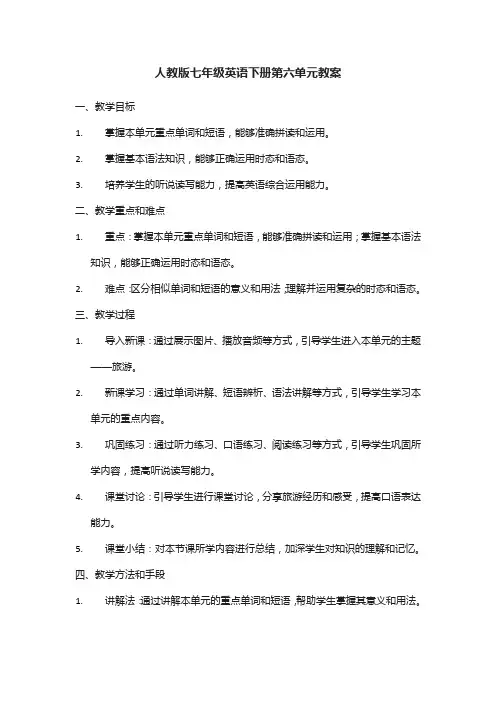
人教版七年级英语下册第六单元教案一、教学目标1.掌握本单元重点单词和短语,能够准确拼读和运用。
2.掌握基本语法知识,能够正确运用时态和语态。
3.培养学生的听说读写能力,提高英语综合运用能力。
二、教学重点和难点1.重点:掌握本单元重点单词和短语,能够准确拼读和运用;掌握基本语法知识,能够正确运用时态和语态。
2.难点:区分相似单词和短语的意义和用法;理解并运用复杂的时态和语态。
三、教学过程1.导入新课:通过展示图片、播放音频等方式,引导学生进入本单元的主题——旅游。
2.新课学习:通过单词讲解、短语辨析、语法讲解等方式,引导学生学习本单元的重点内容。
3.巩固练习:通过听力练习、口语练习、阅读练习等方式,引导学生巩固所学内容,提高听说读写能力。
4.课堂讨论:引导学生进行课堂讨论,分享旅游经历和感受,提高口语表达能力。
5.课堂小结:对本节课所学内容进行总结,加深学生对知识的理解和记忆。
四、教学方法和手段1.讲解法:通过讲解本单元的重点单词和短语,帮助学生掌握其意义和用法。
2.演示法:通过展示图片、播放音频等方式,引导学生了解本单元的主题和内容。
3.练习法:通过听力练习、口语练习、阅读练习等方式,引导学生巩固所学内容,提高听说读写能力。
4.互动法:通过课堂讨论等方式,引导学生进行互动交流,提高口语表达能力和合作学习能力。
五、课堂练习、作业与评价方式1.课堂练习:进行听力练习、口语练习、阅读练习等活动,帮助学生巩固所学内容。
2.家庭作业:布置相关单词、短语和语法的练习题,加强学生的记忆和理解。
3.评价方式:通过平时练习、家庭作业、期中考试等方式进行评估,了解学生的学习情况和进步程度。
六、辅助教学资源与工具1.教学课件:提供清晰明了的教学课件,方便学生理解和记忆。
2.教学视频:提供相关的教学视频,帮助学生更好地掌握知识点。
3.在线测试:提供在线测试平台,方便学生进行自我检测和学习进度的了解。
4.教学工具:提供录音机、投影仪等教学工具,帮助学生更好地参与到课堂中。
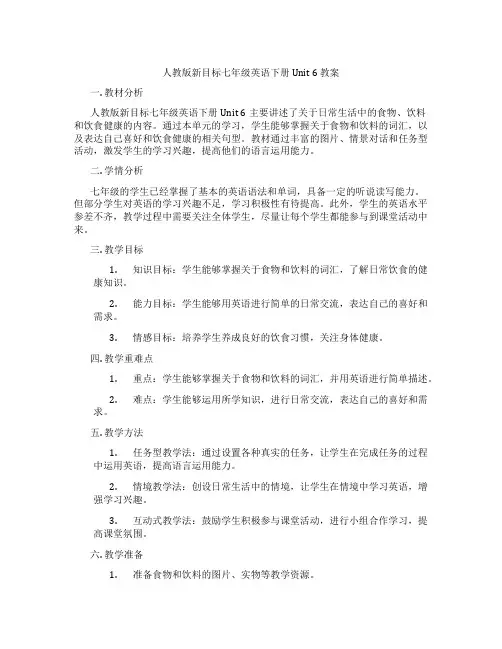
人教版新目标七年级英语下册 Unit 6 教案一. 教材分析人教版新目标七年级英语下册Unit 6主要讲述了关于日常生活中的食物、饮料和饮食健康的内容。
通过本单元的学习,学生能够掌握关于食物和饮料的词汇,以及表达自己喜好和饮食健康的相关句型。
教材通过丰富的图片、情景对话和任务型活动,激发学生的学习兴趣,提高他们的语言运用能力。
二. 学情分析七年级的学生已经掌握了基本的英语语法和单词,具备一定的听说读写能力。
但部分学生对英语的学习兴趣不足,学习积极性有待提高。
此外,学生的英语水平参差不齐,教学过程中需要关注全体学生,尽量让每个学生都能参与到课堂活动中来。
三. 教学目标1.知识目标:学生能够掌握关于食物和饮料的词汇,了解日常饮食的健康知识。
2.能力目标:学生能够用英语进行简单的日常交流,表达自己的喜好和需求。
3.情感目标:培养学生养成良好的饮食习惯,关注身体健康。
四. 教学重难点1.重点:学生能够掌握关于食物和饮料的词汇,并用英语进行简单描述。
2.难点:学生能够运用所学知识,进行日常交流,表达自己的喜好和需求。
五. 教学方法1.任务型教学法:通过设置各种真实的任务,让学生在完成任务的过程中运用英语,提高语言运用能力。
2.情境教学法:创设日常生活中的情境,让学生在情境中学习英语,增强学习兴趣。
3.互动式教学法:鼓励学生积极参与课堂活动,进行小组合作学习,提高课堂氛围。
六. 教学准备1.准备食物和饮料的图片、实物等教学资源。
2.设计相关的情景对话和任务型活动。
3.准备课堂用语和教学PPT。
七. 教学过程1.导入(5分钟)利用图片和实物,引导学生谈论他们喜欢吃的食物和饮料。
激发学生的学习兴趣,导入新课。
2.呈现(10分钟)展示食物和饮料的图片,引导学生用英语进行描述。
呈现相关词汇和句型,让学生跟读并模仿。
3.操练(15分钟)设置情境对话,让学生分组进行角色扮演。
鼓励学生大胆开口,提高口语表达能力。
4.巩固(10分钟)设计任务型活动,让学生分组讨论日常饮食的健康知识。
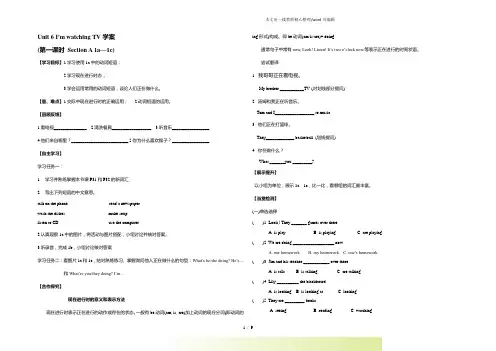
Unit 6 I'm watching TV学案(第一课时Section A 1a—1c)【学习目标】1.学习使用1a中的动词短语;2.学习现在进行时态;3.学会运用常用的动词短语,谈论人们正在做什么。
【重、难点】1.交际中现在进行时的正确运用; 2.动词短语的运用。
【回顾反馈】1.看电视_______________2.清洗餐具__________________3.听音乐_________________4.他们来自哪里?__________________________5.你为什么喜欢猴子?_________________【自主学习】学习任务一:1.学习并熟练掌握本节课P31和P32的新词汇.2.写出下列短语的中文意思。
talk on the phone read a newspaperwash the dishes make souplisten to CD use the computer2.认真观察1a中的图片,将活动与图片搭配,小组讨论并核对答案。
3.听录音,完成1b,小组讨论核对答案.学习任务二:看图片1a和1c,结对熟练练习、掌握询问他人正在做什么的句型:What’s he/she doing?He’s…和What’re you/they doing?I’m …【合作探究】现在进行时的意义和表示方法现在进行时表示正在进行的动作或存在的状态。
一般有be动词(am, is, are)加上动词的现在分词(即动词的ing形式)构成。
即be动词(am/is/are)+ doing通常句子中常有now, Look! Listen! It’s two o’clock now.等表示正在进行的时间状语。
尝试翻译1.我哥哥正在看电视。
My brother ___________TV. (对划线部分提问)2. 汤姆和我正在听音乐。
Tom and I__________________ to music .3. 他们正在打篮球。
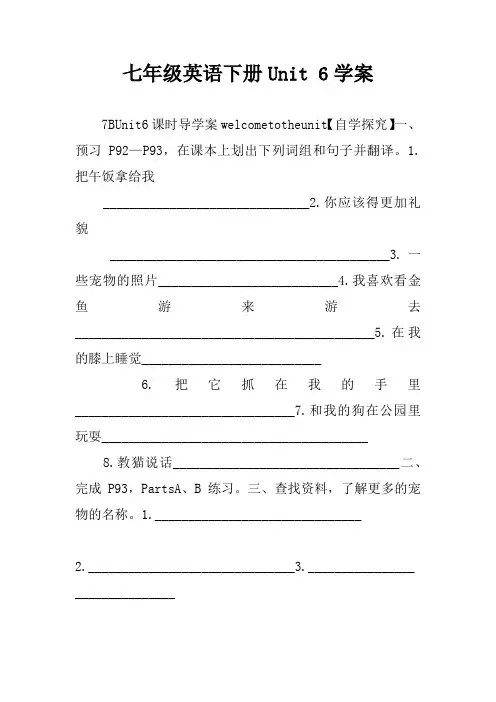
七年级英语下册Unit 6学案7BUnit6课时导学案welcometotheunit【自学探究】一、预习P92—P93,在课本上划出下列词组和句子并翻译。
1.把午饭拿给我_______________________________2.你应该得更加礼貌__________________________________________3.一些宠物的照片___________________________4.我喜欢看金鱼游来游去_____________________________________________5.在我的膝上睡觉___________________________6.把它抓在我的手里_________________________________7.和我的狗在公园里玩耍________________________________________8.教猫说话__________________________________二、完成P93,PartsA、B练习。
三、查找资料,了解更多的宠物的名称。
1._______________________________2._______________________________3.________________ _______________4._______________________________5.________________ _______________6._______________________________【教案】教学内容7BUnit6welcometotheunit课型新授课教学目标1.Tointroducestudentstotheworldofpets2.Toidentifyna mesofanimalsandtypicalfeatures3.Tounderstanddiffere ncesinanimalfeatures教学重难点1.Toidentifynamesofanimalsandtypicalfeatures2.Phras es:bringsbsthbemorepoliteswimaroundonone’slapholdsthinone’shandfeedsbsthteachsbtodosth教学方法Task-basedapproach教具准备multimedia教学步骤教师活动学生活动个性化补充StepILeading-in1.Guidestudentstorecallthenamesofsomeanim alsthattheylearnt.Askstudents:Doyoulikeawhatanimals doyouknow?Ifyoulikeananimalverymuch,youcankeepitasa petinyourflat.whatanimaldoyouwanttokeepasapet?2.Studentsgivetheanswers.StepIIPresentation1Presentstudentssomepictures,suchasacat,adog,arabbit ,agoldfish,amouse,aparrot,etc.2Talkwithstudents:1).T:whatisit?S:Itisarabbit.T:Doyo ulikeit?S:yes,Ilikeitverymuch.T:whydoyoulikeit?S:B ecauseitislovely.Ithastwolongears.Itoftenjumpsand runshereandthere.Icanfeeditcarrotswhenitishungry.Thatwillbeinteresting.2)T:what’sthis?S:It’saparrot.T:whydoyoulikeit?S:Itcanspeakandsinglikeap erson.That’swonderful!Ifeelhappywhenitiswithme.AndIcanteachit tospeak.3)T:whatdoyouthinkaboutthemouse?S:oh,itissmallandsoft .T:Icanholditinmyhand.maybesomepeopledon’tlikeit,butIthinkitissmartandlovely4)T:Ilikegoldfishverymuch,andyou?S:Ilikewatchingitswimaround.Itstailissobeau tifulwhenitisswimming.Howhappyandfreeitisinwater!5) T:Girlsusuallylikecats,butoneofmyfriendsdoesn’t.S:why?T:Itoftenlikestosleeponherlap,soshecan’tdoanything.3.Teachnewwords.StepIIITask1.EncouragestudentstodothetaskinPartAonPage932.Dividetheclassintopairs.Askstudentstocomparetheiran swersanddiscussanydisagreements.3.StudentsdoPartBasaquiz.Studentsclosetheirbooks.your eadthesentencesa-fandstudentshavetoguesstheanswer.T hestudentwhoanswersfirstgetsapoint.4.Askstudentstoprepareasentenceabouttheirfavoritepet. Tellthemtopretendthattheyhaveapetiftheydonotownone. 5.Askstudentstosharetheirsentences.StepIVPresentation1.TellstudentsEddiealsohasapet—Hobo.Listentotheirconversationandanswerthefollowin gquestion:IsHoboagoodpet?2.Playthetapeforstudentstofindtheans wer.3.PlaythetapeagainandaskwhatdoesEddiewant?Howdo esHoborespond?whyisHobounhappy?4.Playthetapeforstud entstolistenandrepeat.StepVHomework通过复习学生学过的有关宠物的词汇帮助学生激起对本单元的话题。
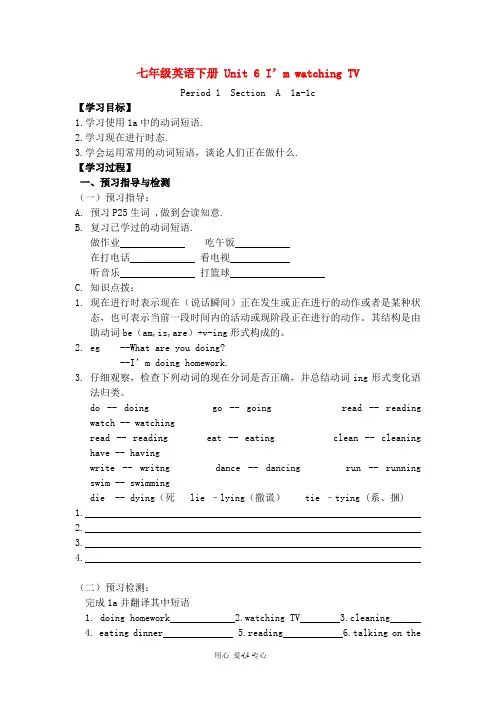
七年级英语下册 Unit 6 I’m watching TVPeriod 1 Section A 1a-1c【学习目标】1.学习使用1a中的动词短语.2.学习现在进行时态.3.学会运用常用的动词短语,谈论人们正在做什么.【学习过程】一、预习指导与检测(一)预习指导:A.预习P25生词 ,做到会读知意.B.复习已学过的动词短语.做作业吃午饭在打电话看电视听音乐打篮球C.知识点拨:1.现在进行时表示现在(说话瞬间)正在发生或正在进行的动作或者是某种状态,也可表示当前一段时间内的活动或现阶段正在进行的动作。
其结构是由助动词be(am,is,are)+v-ing形式构成的。
2.eg --What are you doing?--I’m doing homework.3.仔细观察,检查下列动词的现在分词是否正确,并总结动词ing形式变化语法归类。
do -- doing go -- going read -- readingwatch -- watchingread -- reading eat -- eating clean -- cleaninghave -- havingwrite -- writng dance -- dancing run -- runningswim -- swimmingdie -- dying(死 lie –lying(撒谎) tie –tying (系、捆)1.2.3.4.(二)预习检测:完成1a并翻译其中短语1. doing homework2.watching TV3.cleaning4. eating dinner5.reading6.talking on thephone二、课堂互动探究1.Pairwork: 使用句型What are you doing? I’m…谈论正在进行的动作。
2.得分小能手:看谁能用现在进行时态造句,并造的又多又准确,注意动词ing的结构哟。
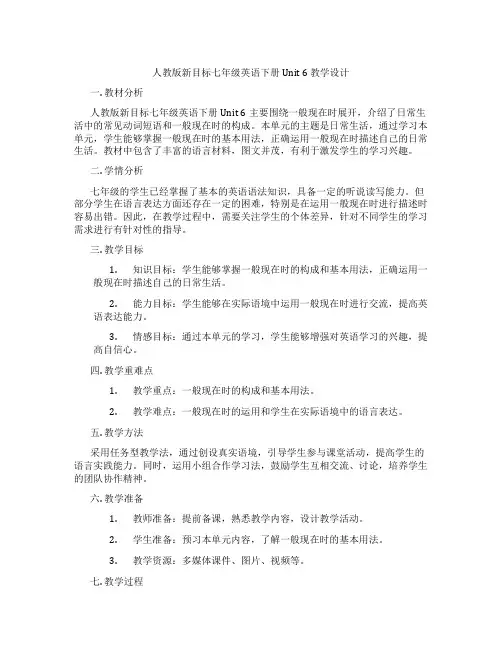
人教版新目标七年级英语下册 Unit 6 教学设计一. 教材分析人教版新目标七年级英语下册Unit 6主要围绕一般现在时展开,介绍了日常生活中的常见动词短语和一般现在时的构成。
本单元的主题是日常生活,通过学习本单元,学生能够掌握一般现在时的基本用法,正确运用一般现在时描述自己的日常生活。
教材中包含了丰富的语言材料,图文并茂,有利于激发学生的学习兴趣。
二. 学情分析七年级的学生已经掌握了基本的英语语法知识,具备一定的听说读写能力。
但部分学生在语言表达方面还存在一定的困难,特别是在运用一般现在时进行描述时容易出错。
因此,在教学过程中,需要关注学生的个体差异,针对不同学生的学习需求进行有针对性的指导。
三. 教学目标1.知识目标:学生能够掌握一般现在时的构成和基本用法,正确运用一般现在时描述自己的日常生活。
2.能力目标:学生能够在实际语境中运用一般现在时进行交流,提高英语表达能力。
3.情感目标:通过本单元的学习,学生能够增强对英语学习的兴趣,提高自信心。
四. 教学重难点1.教学重点:一般现在时的构成和基本用法。
2.教学难点:一般现在时的运用和学生在实际语境中的语言表达。
五. 教学方法采用任务型教学法,通过创设真实语境,引导学生参与课堂活动,提高学生的语言实践能力。
同时,运用小组合作学习法,鼓励学生互相交流、讨论,培养学生的团队协作精神。
六. 教学准备1.教师准备:提前备课,熟悉教学内容,设计教学活动。
2.学生准备:预习本单元内容,了解一般现在时的基本用法。
3.教学资源:多媒体课件、图片、视频等。
七. 教学过程1.导入(5分钟)教师通过展示日常生活场景的图片,引导学生谈论自己的日常生活,为新课的学习营造轻松的氛围。
2.呈现(10分钟)教师通过PPT展示一般现在时的构成和基本用法,让学生初步感知一般现在时的概念。
3.操练(15分钟)教师设计一系列听力、口语活动,让学生在实际语境中运用一般现在时进行表达。
如:听力练习、角色扮演等。
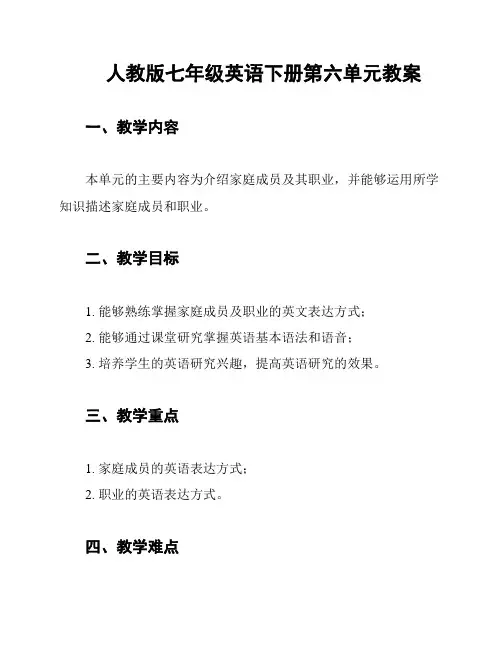
人教版七年级英语下册第六单元教案一、教学内容本单元的主要内容为介绍家庭成员及其职业,并能够运用所学知识描述家庭成员和职业。
二、教学目标1. 能够熟练掌握家庭成员及职业的英文表达方式;2. 能够通过课堂研究掌握英语基本语法和语音;3. 培养学生的英语研究兴趣,提高英语研究的效果。
三、教学重点1. 家庭成员的英语表达方式;2. 职业的英语表达方式。
四、教学难点1. 熟练掌握家庭成员及职业的英文表达方式;2. 正确使用英语基本语法和语音。
五、教学准备1. 教师应提前准备好相关的教学课件和教材;2. 确认教学设备的正常工作。
六、教学过程设计七、板书设计1. 本节课内容:家庭成员&职业;2. 家庭成员表达:father, mother, sister, brother, grandfather, grandmother;3. 职业表达:doctor, teacher, student, police officer, postman, artist;4. 语音表达:单词发音、语调;5. 语法:be动词和助动词的使用。
八、作业布置1. 背诵本课程所学单词;2. 总结be动词和助动词的用法。
九、教学反思本节课的教学目标得到了很好的完成,学生学习欲望强烈、表现活跃,课堂氛围良好。
其中,小组讨论、学生扮演角色等互动方式,很好地激发了学生的学习热情,也帮助到了学生发挥个人特长。
但有些学生课前准备不够充分,导致课堂效果有些不够理想。
在后续的教学过程中,我将更加注重学生课前准备的重要性。
同时在交流中,更加清晰明确地表达英语语法规则,使学生能够更好地理解和应用。
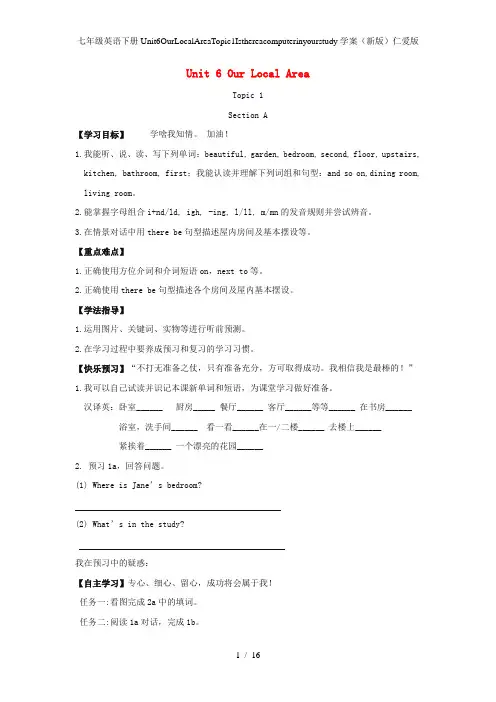
Unit 6 Our Local AreaTopic 1Section A【学习目标】学啥我知情。
加油!1.我能听、说、读、写下列单词:beautiful, garden, bedroom, second, floor, upstairs, kitchen, bathroom, first;我能认读并理解下列词组和句型:and so on,dining room, living room。
2.能掌握字母组合i+nd/ld, igh, -ing, l/ll, m/mn的发音规则并尝试辨音。
3.在情景对话中用there be句型描述屋内房间及基本摆设等。
【重点难点】1.正确使用方位介词和介词短语on,next to等。
2.正确使用there be句型描述各个房间及屋内基本摆设。
【学法指导】1.运用图片、关键词、实物等进行听前预测。
2.在学习过程中要养成预习和复习的学习习惯。
【快乐预习】“不打无准备之仗,只有准备充分,方可取得成功。
我相信我是最棒的!”1.我可以自己试读并识记本课新单词和短语,为课堂学习做好准备。
汉译英:卧室______ 厨房_____ 餐厅______ 客厅______等等______ 在书房______ 浴室,洗手间______ 看一看______在一/二楼______ 去楼上______紧挨着______ 一个漂亮的花园______2. 预习1a,回答问题。
(1) Where is Jane’s bedroom?(2) What’s in the study?我在预习中的疑惑:【自主学习】专心、细心、留心,成功将会属于我!任务一:看图完成2a中的填词。
任务二:阅读1a对话,完成1b。
任务三:再读1a对话,完成1c短文填空。
任务四:听4a字母及字母组合发音,然后大声跟读单词, 并完成4a和4b。
【合作学习】1. 小组对学:检查快乐预习完成情况。
互学单词,大声朗读,互相纠正发音。
2. 小组对学:大声朗读1a对话,为对话表演做好准备。
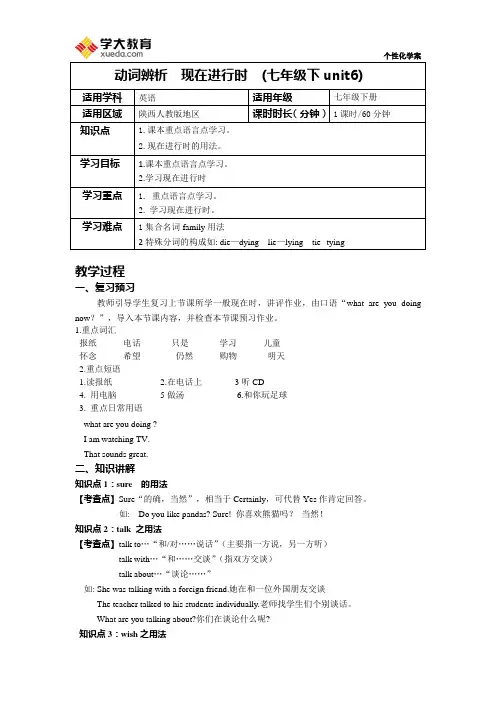
教学过程一、复习预习教师引导学生复习上节课所学一般现在时,讲评作业,由口语“what are you doing now?”,导入本节课内容,并检查本节课预习作业。
1.重点词汇报纸______电话______只是______ 学习______儿童______怀念______希望______仍然______购物______ 明天______2.重点短语1.读报纸__________2.在电话上_______ 3听CD__________4. 用电脑_________5做汤___________6.和你玩足球_________________3. 重点日常用语what are you doing ?_________________I am watching TV._________________That sounds great. _________________二、知识讲解知识点1:sure 的用法【考查点】Sure“的确,当然”,相当于Certainly,可代替Yes作肯定回答。
如: Do you like pandas? Sure! 你喜欢熊猫吗?当然!知识点2:talk 之用法【考查点】talk to…“和/对……说话”(主要指一方说,另一方听)talk with…“和……交谈”(指双方交谈)talk about…“谈论……”如: She was talking with a foreign friend.她在和一位外国朋友交谈The teacher talked to his students individually.老师找学生们个别谈话。
What are you talking about?你们在谈论什么呢?知识点3:wish之用法【考查点】wish sb sth 祝愿某人某事wish(sb)to do sth 希望(某人)做某事如: We wish you a happy new yearI wish you to go知识点4:family“家庭,家人”,集合名词。
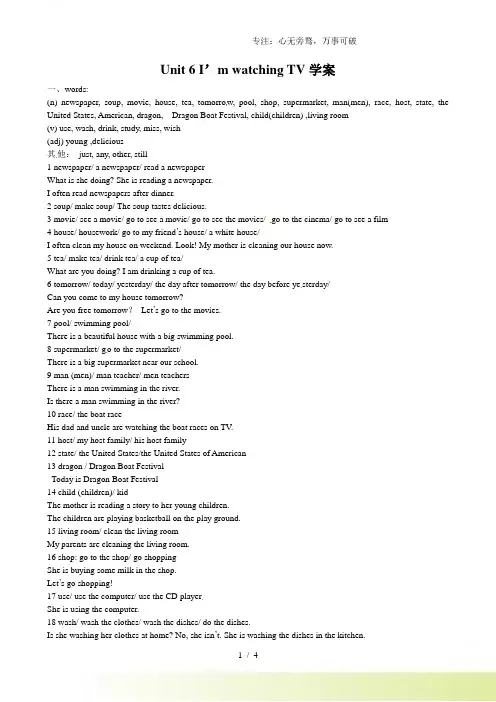
Unit 6 I’m watching TV学案一、words:(n) newspaper, soup, movie, house, tea, tomorro w, pool, shop, supermarket, man(men), race, host, state, the United States, American, dragon, Dragon Boat Festival, child(children) ,living room(v) use, wash, drink, study, miss, wish(adj) young ,delicious其他:just, any, other, still1 newspaper/ a newspaper/ read a newspaperWhat is she doing? She is reading a newspaper.I often read newspapers after dinner.2 soup/ make soup/ The soup tastes delicious.3 movie/ see a movie/ go to see a movie/ go to see the movies/ go to the cinema/ go to see a film4 house/ housework/ go to my friend’s house/ a white house/I often clean my house on weekend. Look! My mother is cleaning our house now.5 tea/ make tea/ drink tea/ a cup of tea/What are you doing? I am drinking a cup of tea.6 tomorrow/ today/ yesterday/ the day after tomorrow/ the day before ye sterday/Can you come to my house tomorrow?Are you free tomorrow?Let’s go to the movies.7 pool/ swimming pool/There is a beautiful house with a big swimming pool.8 supermarket/ g o to the supermarket/There is a big supermarket near our school.9 man (men)/ man teacher/ men teachersThere is a man swimming in the river.Is there a man swimming in the river?10 race/ the boat raceHis dad and uncle are watching the boat races on TV.11 host/ my host family/ his host family12 state/ the United States/the United States of American13 dragon / Dragon Boat FestivalToday is Dragon Boat Festival14 child (children)/ kidThe mother is reading a story to her young children.The children are playing basketball on the play ground.15 living room/ clean the living roomMy parents are cleaning the living room.16 shop: go to the shop/ go shoppingShe is buying some milk in the shop.Let’s go shopping!17 use/ use the computer/ use the CD playerShe is using the computer.18 wash/ wash the clothes/ wash the dishes/ do the dishes.Is she washing her clothes at home? No, she isn’t. She is washing the dishes in the kitchen.19 drink/ drink a cup of tea/ drink some water/ drink tea/Mary’s parents drink tea after dinner.20 study/ study EnglishShe is studying in the United States.21 miss/miss my hometown/ miss my motherShe really miss her best friend.22 wish/best wishes/ I wish to have my mom’s delicious food.23 young- old/ the young/ the old/24 delicious/ delicious food/二、phrases (短语)1 read a newspaper---reading a newspaper2 talk on the phone--- talking on the phone3 go to the movies---going to the movi es4 make soup---making soup5 make dinner----making dinner6 wash the dishes—washing the dishes7 wash my clothes---washing my clothes8 drink tea---drinking tea9 clean the living room---cleaning the living room10 talk on the phone—talking on the phone11 listen to a CD--- listening to a CD12 use the computer---using the computer13 exercise---exercising14 do my homework---doing my homework15 clean the house----cleaning the house16 join me /join me for dinner/ Do you want to join me for dinner?17 eat outMy parents aren’t at home. We can eat out.18 at half past six19 see you/ see you tomorrow./see you then/ see you tomorrow evening.20 what about you/ how about you21 It is kind of boring/ It is not very interesting22 That sounds good./ That sounds boring.23 play basketball at school24 buy milk and bread in the supermarket25 swim in the swimming pool/ swim in a river26 read a newspaper in the library27 study in the United States28 live with an American in New York29 Dragon Boat Festival30 watch the boat race on TV/ watch a soccer game on TV/ watch … on TV31 read a story to her young children32 wish to have his mom’s delicious food/wish to do sth33 like his host family a lot/= like his host family very much/ like… a lot34 the night before the festival35 his host family36 talk on the phone to his cousin37 miss his family38 no place like home39 a picture of my family40 in the living room41 listen to the radio42 talk show / This talk show is interesting.TV show /My TV show in also not very interesting.43 study for a test/ He is studying for a test.44 play soccer with me/三、句型1 (1) I’m watching TV.---- I’m not watching TV. Are you watching TV?--- Yes, I am./ No, I’m not. What are you doing ?(2) She is talking on the phone.She isn’t talking on the phoneIs she talking on the phone?Yes, she is./ No, she isn’t .What is she doing?(3) He is reading a newspaper.He isn’t reading a newspaper.Yes, he is./ No, he isn’t.What is he doing?(4)They are washing the dishes.They aren’t washing the dishes.Are they washing the dishes?Yes, they are. No, they aren’t.What are they doing?2 Do you want to go to the movies?Do you want to join me for dinner?Do you want to play basketball with me?Do you want to go to the zoo with your frien ds?3 What are you doing?—not much.4 Let’s meet at my home first.Let’s go to see the pandas first.Let’s play the guitar fi rst.5 Hello? This is Jenny./ It is Jenny speaking.---Hi, Jenny. It is Laura here./ This is Laura.Is that Jack speaking?/ Is it Jack speaking?6 Would you like to go to the movies with me? Yes, I’d love to.7 I am just washing my clothes.8 My parents aren’t at home. We can eat out.9 What time is it in Beijing?—it is eight o’clock in the morning.What is the time now?= What time is it now?10 Today’s story is about Zhu Hui.11 He is now studying in the Unit ed States.He is living with an American family in New York.His mom and aunt are making zongzi. His dad and uncle are watching the boat race on TV.The mother is reading a story to her young children.The father is watching a soccer game on TV. He is talking on the phone to his cousin in Shenzhen.12 In New York, it is the night before the festival. But there isn’t a Dragon Boat Festival in the US, so it is like any other night for Zhu Hui and his host family.13 Zhu Hui misses his family and wishes to have his mom’s delicious zongzi.14 Here is a picture of my family. We are all at home now.。
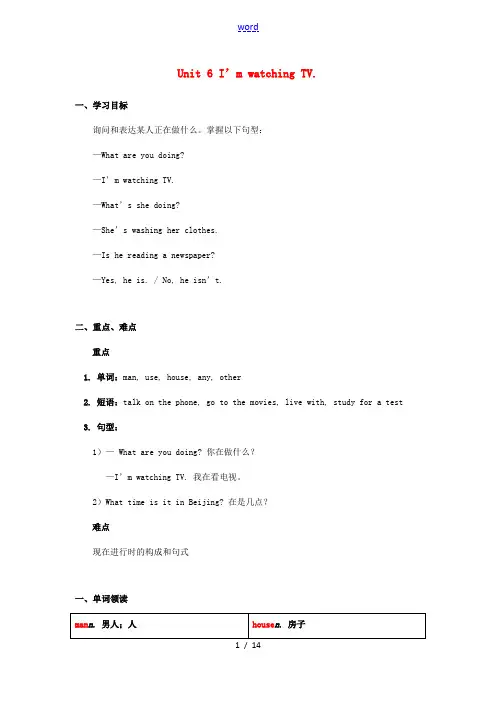
Unit 6 I’m watching TV.一、学习目标询问和表达某人正在做什么。
掌握以下句型:—What are you doing?—I’m watching TV.—What’s she doing?—She’s washing her clothes.—Is he reading a newspaper?—Yes, he is. / No, he isn’t.二、重点、难点重点1. 单词:man, use, house, any, other2. 短语:talk on the phone, go to the movies, live with, study for a test3. 句型:1)— What are you doing? 你在做什么?—I’m watching TV. 我在看电视。
2)What time is it in Beijing? 在是几点?难点现在进行时的构成和句式一、单词领读use v.使用;运用other adj. 另外的;其他的pron.另外的人(或物)any adj.任何的;任一的pron.任何;任一二、重点单词【单词学习】☆☆1. use v.使用;运用【用法】及物动词。
【例句】—Can I use your bike? 我可以用一下你的自行车吗?—Sure. 当然可以了。
【拓展】(1)use n.用法;使用;用途(2)useful adj.有用的;有益的(3)useless adj.无用的【例句】He makes good use of his time. 他充分利用他的时间。
English is useful to you. 英语对你来说有用。
Why do you think it’s useless? 你为什么认为它没用呢?【考题】Can you help me ______ the puter? I think it’s very _______.A. use; usefulB. to use; uselessC. useful; useD. use; useless答案:A思路分析:help sb. (to) do sth.,故C项错误;根据前句“你能帮助我使用电脑吗?”可知“我认为它是很有用的”,故用useful。
初中英语七年级下册Unit6 I’m watching TVSection A 2d-3c一、学习目标1、知识与技能:重点单词:newspaper, use, soup, wash, movie;重点短语:read a newspaper, make soup, talk on the phone, wash the dishes, listen to a CD;重点句式:1.What are you doing?2. He is using the computer.2、过程与方法:熟练掌握现在进行时问答方法。
3、情感态度与价值观:学会如何用进行时态进行人际交流,体会汉英两种语言之间的异同。
二、学习重难点现在进行时动词doing形式的转换三、课堂导学Step1 导入1、观看小视频提炼视频中句型。
What are you doing?What is he doing?2、new words 练习句型Step 2完成教材1a、1c的任务1.先观察la中的图片,尽可能多地说出他们的活动。
2.将所给的短语和图片中的活动相匹配,并朗读图片中的对话,练习此对话。
3.1c给出目标句型,根据1a短语进行操练Step3 听力训练1.1b听力2.1b listen again and write3.2a 2b听力任务4.listen and repeatStep 4 Think结合当前实际情况回答下列问题What are you doing now?What are your teachers doing now?What is your mother doing now?What is your father doing now?What are the doctors and nurses(护士) doing now?What is the cleaner(清洁人员) doing ?What are the building workers doing ?What is the girl doing ?Step 5 Summary——What are you doing? ——I'm ...——What is he/she doing? ——He/She is ...——What are they doing? ——They're ...watching TV / cleaning / reading a newspaper/newspapers / talking on the phone / listening to a CD / using the computer / washing thedishes / exercisingStep 6 Homework1.Practice the conversations we learned and try to make other conversations by yourself2.Find out how to change a verb(do—doing)and give some examples。
七年级英语·下新目标【人】Unit 6 I’m watching TV.1.掌握并使用本单元词汇,运用现在进行时描述正在做的事情,掌握现在分词的构成规律。
2.掌握现在进行时中的特殊疑问句和一般疑问句的构成及其回答。
能够区分现在进行时和一般现在时的用法差异。
3.通过阅读和写作练习,学会对某一场景或图片上人们正在做的事情进行描述,完成笔头输出。
以图片和视频创设情景教学描述人们正在做的事情的现在进行时的句子,从中学会现在进行时的特殊疑问句和一般疑问句的构成和回答,学会动词现在分词的构成和使用,区分现在进行时和一般现在时的用法差异,通过听力训练和师生的对话训练学生的听、说能力,培养学生流利地用本单元知识内容来谈论自己或图片上的人们正在做的事情。
通过独自思考和小组合作的方式完成阅读活动,归纳阅读信息,了解中西方文化中的传统节日,并通过模仿写出描述照片或图片的语篇。
教学突破:运用图片和动作创设语境,教学新的动词现在分词、短语和正在做事情的句型,以听说读写的任务引导学生开展课堂活动,要求学生在活动中训练、运用所学的单词、短语和句型,重视听说能力的培养,从家庭里的日常活动到打电话中不同地方的人们的活动练习、运用现在进行时。
在练习中学会使用动词的现在分词,学会询问和回答现在进行时的特殊疑问句和一般疑问句,对人们正在做的事情进行描述。
以阅读材料做范文,学会模仿范文、自己整理材料写出描述照片或图片上的人物正在做的事情。
通过比较学习、掌握现在进行时态与一般现在时态的构成、使用以及时间状语方面的差异。
注重方法与价值观的培养:结合图片上的信息和自己的动作,在语境中大量感知和训练本单元中出现的正在做某事的句子、学会动词的现在分词的构成,通过比较学习现在进行时和一般现在时在用法、构成和使用时间状语方面的差异,提高综合运用语言的能力。
通过单元的语言学习,归纳、总结本单元出现的what引导的现在进行时特殊疑问句及其回答的句型,以及比较现在进行时和一般现在时的不同用法,使知识的记忆形象化、系统化。
七年级英语下册第六单元学案Unit6 Ifs raining第 1 课时Section A la - lc【学习目标】1 .词汇:rain, windy, cloudy,sunny, snow ,weather ,Moscow , Boston2.掌握询问天气的句型:How,s the weather?(= What,s the weather like ?)It' s sunny/raining/windy/cloudy/snowing/【课前预习】1.根据音标,拼读本课的新单词2.写出下列单词的形容词形式sun _____ cloud ________ wind _______ rain ______ snow ______观察这些词,你会得到什么规律?【合作探究】1.根据la图片将图画与左边的单词对应2.学习句型:----- How' s the weather?----- It,s raining3.运用此句型进行操练,通过操练掌握此句型,并引出How' s the weather?同义句What' s the weather like?4.完成lb部分的听力任务;再听录音,跟读对话;分角色朗读对话并表演。
【课堂检测】一、用所给词的适当形式填空1、How's the weather there? Ifs (rain).2、The is shining. Ifs .(sun)3、There are a lot of in the sky. Ifs .(cloud)4、It often (rain) in summer in my hometown.5、The weather is (wind)and cold.6、-How's the weather in Harbin? -Ifs _____ (snow).二、会话配对。
(5)()1. Do you like cold weather? A. Ifs cold.()2. How's the weather in Moscow? B. S-N-O-W.()3. What are you doing? C. No, I don't.()4. How do you spell ”snow”? D. Pm studying.三、对划线部分提问Ifs cloudy._______ is the weather?_______ the weather ______ ?第 2 课时Section A 2a -4【学习目标】1.掌握词汇:cook,study,bad,terrible,pretty2.掌握句型:一How' s the weather in Beijing? 一It' s sunny一How is it going? 一It' s pretty good.3.掌握与天气状况有关的词汇和句型并学会询问人的现状。
Unit 6 I’m watching TV.教材来源:初中七年级《英语》教科书内容来源:七年级《英语(下册)》第六单元主题:I’m watching TV.课时:共4课时授课对象:七年级学生设计者:李昆鹏/巩义市直第二初级中学目标确定的依据1.课程标准相关要求课程标准三级目标要求七年级学生能听懂较慢语速、熟悉话题的简单对话;识别主题,获取主要信息;能引出话题并进行交谈,并能在口语活动中使用正确的语音语调。
2.教材分析本单元要求学生能运用现在进行时来谈论正在进行的活动。
SectionA 集中呈现了一些家庭活动的动词短语并通过打电话的情景对话输入现在进行时的语言结构,训练学生运用该结构来表达和谈论正在发生的事情。
SectionB通过谈论活动发生的地点,来巩固现在进行时态的一般疑问句及其回答,同时呈现了以重读闭音节结尾的动词如何构成Ving的形式。
3.学情分析学生在小学阶段初步学习过现在进行时的用法,这些为七年级顺利学习现在进行时奠定了知识基础。
本单元内容是第一次出现的新时态,在运用时,学生可能会与一般现在时混淆或在现在分词构成规则的使用上出现错误。
Unit6 I’m watching TV第一课时SectionA1a –2c学习目标1.通过课堂练习,能准确说出本节课所学5个单词及6个短语。
2.通过小组活动,能够用现在进行时谈论自己或他人正在进行或发生的动作。
3.通过听力练习,能准确提取出听力材料中现在进行时句型以及对事物看法的形容词。
评价任务1.目标1 通过图片,检查学生掌握单词和短语.2.目标2 通过Task 1 Task 2 Task 3的展示,检查学生是否能够谈论自己或他人正在进行或发生的动作。
3.目标3 通过听力练习,检查学生对本节短语和现在进行时的掌握。
学习过程Step1 Lead inShow some pictures and review new words and phrasesAssessment 1 C check how many students can say words and phrases correctly. Step2 PresentationTask 1用 1 a中的短语和句型同桌互相讨论正在做的事情。
人教版英语7年级下第六单元复习教案 (人教版英语七年级)Unit 6 It’s raining.复习案ⅠTeaching Aims and Demands1. Knowledge ObjectsIn this unit students students learn to talk about the weather and talk about what people are doing2. Ability ObjectTrain students’ listening, speaking, reading and writing skills.Train students’ communicative competence.3. Moral ObjectLearn how to talk about the weather.Ⅱ. Teaching Key PointsKey words :raining, sunny, cloudy, windy, snowing, snowyThe target languageWhat are you doing? I'm watching TVWhat's he doing? He's playing basketball.What's she doing? She's cooking.What are they doing? They're studying.How's the weather? It's raining.Ⅲ. Teaching DifficultiesTrain students’ listening, speaking, reading and writing skills..Review how to talk about the weather.Review how to write weather report.Ⅳ. Teaching MethodsPairworkPracticing methodsⅤ. Teaching AidsA computerCardsⅥ. Teaching ProceduresStepⅠHow is the weather? It’s raining.How is the weather in Beijing? It’s sunny.What are you doing? I’m reading books.What are they doing? They are studying.What’s she doing? She is singing.How is the weather in Beijing? It’s snowing.How is it going? Great.StepⅡ P air work-talk about the weather.Use these target language to make a conversation with your partner.How is the weather?It’s raining.How is the weather in Beijing?It’s sunny.What are you doing? I’m reading books.What are they doing? They are studying.What’s she doing? She is singing.How is the weather in Beijing? It’s snowing.How is it going? Great.StepⅢ Review the structures1. Review the Yes/No questions. Write sentences on your exercise book. Write as many as you can.2. Ask several students to read their sentences.StepⅣ Review the key vocabulary1. Give students several minutes to memorize the keyvocabulary.raining, sunny, cloudy, windy, snowing, snowy.2. Have a dictation.StepⅤ SummaryIn this class we’ve reviewed all the key words in this unit .StepⅥ HomeworkReview all the key words and language points learned in this unit.Blackboard DesignUnit 6 It’s raining.How’s the weather? It’s sunny.What are you doing? I’m reading.How’s it going? Great.教学反思:。
Unit 6 It's rainingSection A年级:七年级科目:英语主备人:杨晓琴审阅人:靳红梅时间:2011.04.7学生:班级:小组评价:综合评价:时间:学习目标:掌握现在进行时,学会问天气词汇: rain,windy,cloudy,sunny,snow,weather,cook,study,bad,terrible,pretty短语:watch Tv ,play computer games, play basketball, pretty good, Not bad交际用语:--How's the weather in Shanghai? --It's cloudy.--What are you doing? --I'm watching TV学习方法及要求:1 小组讨论,合作学习 2 组长负责,兵教兵学前准备:1 学案 2 课本 3 笔记本学习过程:Step1. 预习导学及自测(1)完成下列单词。
下雨______ 下雪________ 有风的________ 阴天的______晴朗_________cook(现在分词) ________study(单数第三人称)_________糟糕的_________Step2 情境导入1.看图片将单词和图片匹配2.看图听1b的录音,把地名填入图中的方框里3.自我练习1c,根据上边的每张图进行问答:A: Hi! How's the weather in Beijing?B: It's sunny.(1) Practice the example conversation.(练习对话)(2) Make your own conversation in pairs.(编写类似的对话)Step3 自主探究(1) 询问天气情况:_____________________ / _____________________?(2) 询问某人正在干什么:______________________________________ ?Step4 达标测试:一、按要求写单词。
1.sun(形容词) ______2.take(-ing形式) _______3.join(单数第三人称)_______4.windy (名词形式) ______5. put(ing形式) _____6. boring (反义词) ______二、用所给词的适当形式填空1、How's the weather there? It's (rain).2、The is shining. It's .(sun)3、There are a lot of in the sky. It's .(cloud)4、It often (rain) in summer in my hometown.5、The weather is (wind)and cold.6、--What he (do)? --He is playing computer (game).7、--What are you doing? --I (watch)TV.8、--How's it (go)?--Great!9、Thank you for (join) our program..10、Look!They (lie) on the beach.三、Match the two halves of the dialogues. 会话配对。
( ) 1. Do you like cold weather? A. It's cold.( ) 2. How's the weather in Moscow? B. Great!( ) 3. What are you doing? C. S-N-O-W.( ) 4. How's it going? D. No, I don't.( ) 5. How do you spell "snow"? E. I'm studying.四、句型转换,一空一词。
1. I'm playing computer games. (变否定句)I ________ ______ ________ computer games.2. They are watching TV. (变一般疑问句)________ ________ watching TV?3. It's cloudy. (对划线部分提问)________ is the weather?4. We are playing basketball. (对划线部分提问)________ are you ________?5.Tom wants to be a doctor(否定句)Tom ________to be a doctor.五、Choose the right answers. 选择填空。
( )1. Aunt Sarah ______ every day.A. play computer gamesB. plays computer gamesC. is playing computer games ( ) 2Tom is ______ lunch.A. haveB. haveingC. having( )3. ______ do you want?A. How much milkB. How much milksC. How many milkStep5.典型例题解析① My brother is reading a book.(否定句)My brother ______ ____ reading a book.解析:否定句be+not,故is not.② It is cloudy in Beijing today. (提问)_________ _______ the weather in Beijing today?③ -北京的天气怎么样?--在下雪呢。
--_______ is the _________like in Beijing? --It __________ ___________.解析:②③主要考查询问天气的两种方式,What's the weather like?/How is the weather?Step6 中考链接1 . What 's the weather like today?A. It's was very cloud.B. It is snow.C. It's rainy. B. It was very cold.[解析] 问今天天气怎样,回答往往用It's sunny./cloudy/windy/snowy/foggy.答案:C2. What does Tom doing? He is ___________.A studyB studyingC a studentD to study[解析] 现在进行时的回答,应该用动词的现在进行时。
答案:DUnit 6It's rainingSection B年级:七年级科目:英语主备人:杨晓琴审阅人:靳红梅时间:2011.4.7学习目标:熟练掌握现在进行时的相关问句及答语,准确使用How's来询问天气。
掌握词汇: vacation, lie, beach, group, cool, surprised, heat, relaxed,短语:on vacation, take a photo, have a good time交际用语:How’s it going? --GreatWhat's she doing? ---She's cooking重难点:区分一般现在时和现在进行时学习方法及要求:1小组讨论,合作学习 2 组长负责,兵教兵学前准备:1 学案 2 课本 3 笔记本学习过程:一、预习导学及自测为……而感谢______________ 世界各地__________在度假______________ 拍照______________在沙滩上______________ 一个非常有趣的地方__________________二、根据句意,补全下列单词。
1. Thank you for j________ CCTV's "Around the World" show.2. Some are t________ photos of the great buildings.3. Look at this group of people p________ beach volleyball.4. How's the weather? It's c________.5. What is the weather like? It's r________.三、根据汉语意思完成句子(一空一词)。
1.有很多人在这儿度假。
There are ________ ________ here ________ ________.2.我们正在巴黎街头漫步,那里阳光明媚。
We are in Paris, _______in the ________. It's _______beautiful, ________day.3. 天空正在下雨时,你在干什么?我在看书。
--What are you ________ when it's ________? --I am ________ a ________.4.一些人正在公园唱歌,另一些人正在骑自行车。
In the park, ________ are ________ songs, ________ are ________ bikes.四、典型例题解析:1、What's he doing? He,s .A swimB swimsC swimming解析:swim的现在分词swimming,故C。
2、The song interesting.A hearsB listensC sounds解析:hear听见,表结果。
listen 听,表过程。
Sound,听起来。
故C。
3、Everyone the answer to the question.A knowsB knowC to know解析:everyone单数主语,故A。
五、中考链接1.The music .A sounds wellB sound wellC sounds good解析:sound是系动词,后跟形容词作表语。